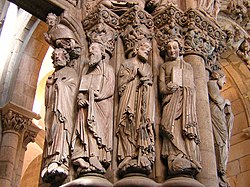Galicia (Spain)
Galicia or Galiza is a nationality in Spain that became a Spanish autonomous community in 1978. It is in the northwest of the Iberian Peninsula. It shares borders with Portugal to the South and the communities of Castile and León and Asturias to the east.
|
Galiza (Galician) | |
|---|---|
 Location of Galicia in Iberia | |
| Coordinates: 42°30′N 8°06′W / 42.5°N 8.1°WCoordinates: 42°30′N 8°06′W / 42.5°N 8.1°W | |
| Country | |
| Capital | Santiago de Compostela |
| Provinces | A Coruña, Lugo, Ourense, and Pontevedra |
| Government | |
| • Type | Devolved government in a constitutional monarchy |
| • Body | Xunta de Galicia |
| • President | Alberto Núñez Feijóo (PPdeG) |
History
Galicia is a green country with Celtic features. Since re-gaining autonomy in 1978, Galicia has been governed by the Xunta de Galicia (government of Galicia). Galicia was strictly governed from 1990 until 2005, during the Manuel Fraga years. The Xunta de Galicia was then under a socialist president Emilio Perez Touriño, who had made Galicia more liberal than ever before, until 2009. From March 2009 Partido Popular (right-wing party) won power and the new president is Alberto Núñez Feijoo, who won a second term as president in 2012.
Language
Galicia has one main language:Galician "galego". It has many similarities with Portuguese. Galego and Portuguese have the same origin. Spanish is also spoken in Galicia, but mainly as a second language.
Cuisine
Galicia is very famous for its fishing industry and seafood remains an important part of its cuisine. A very popular dish in Galicia is polbo á feira, ("polbo" means octopus). There are many restaurants that serve seafood in Galicia.
Galicia (Spain) Media
Bronze Age gold helmet from Leiro, Rianxo
Palloza houses in eastern Galicia, an evolved form of the Iron Age local roundhouses
Castro de Baroña, an Iron Age fortified settlement
A local Iron Age head warrior from Rubiás, Bande. Now in Museo Provincial de Ourense.
Miro, king of Galicia, and Martin of Braga, from an 1145 manuscript of Martin's Formula Vitae Honestae, now in the Austrian National Library. The original work was dedicated to King Miro with the header "To King Miro, the most glorious and calm, the pious, famous for his Catholic faith"
Partial view of the Romanesque interior of the Cathedral of Santiago de Compostela
An illustration of the Cantigas de Santa Maria (13th century)









